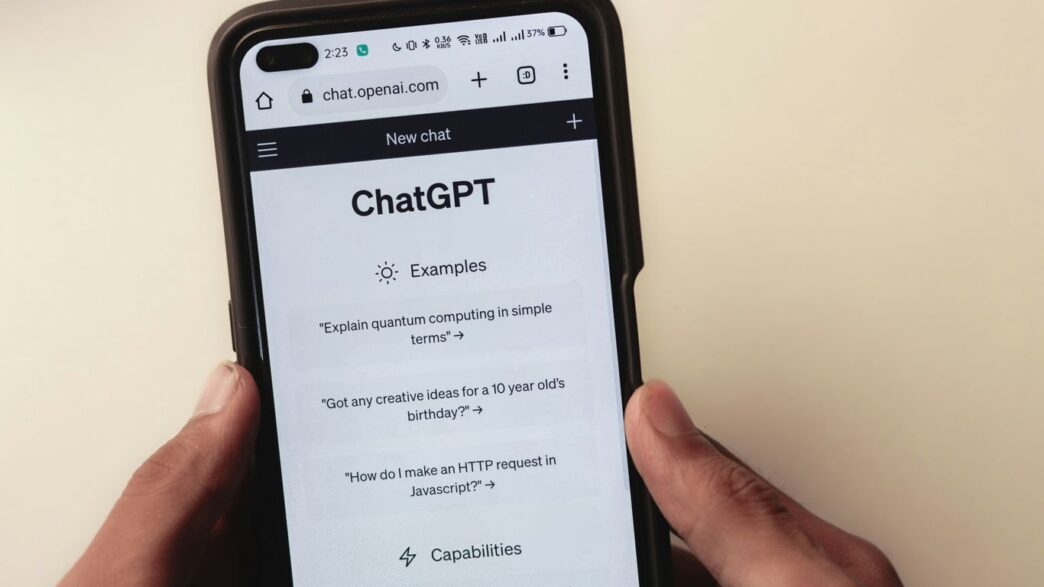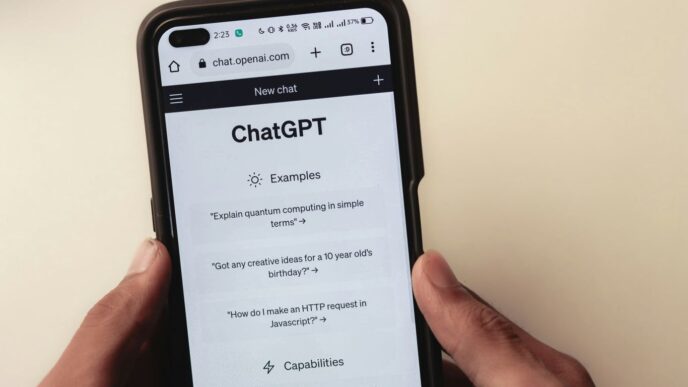The Evolving Landscape of AI Chat
AI chat has really come a long way, hasn’t it? It feels like just yesterday we were dealing with those clunky bots that could barely understand a simple question. Now, we’re seeing AI that can actually hold a conversation, remember what we talked about, and even anticipate what we might need next. It’s pretty wild.
From Simple Scripts to Sophisticated Systems
Think back to the early days. Chatbots were basically just fancy scripts. They followed a set path, and if you went off-road, they’d get lost. It was all about pattern matching – if you said X, it would spit out Y. This basic approach, while groundbreaking at the time, was pretty limited. Today, though, we’re talking about systems that use complex algorithms to understand intent, context, and even subtle nuances in language. It’s the difference between a choose-your-own-adventure book and a real-time, adaptive story.
The Role of Machine Learning and NLP
So, what’s powering this leap? A lot of it comes down to machine learning (ML) and natural language processing (NLP). ML allows these systems to learn from vast amounts of data, getting better and more accurate over time without being explicitly programmed for every single scenario. NLP, on the other hand, is what gives them the ability to actually understand and generate human language. It’s how they can parse sentences, figure out the meaning behind words, and then construct responses that sound natural, not like a robot reading a manual. It’s a constant process of learning and refinement.
Context-Aware Interactions and Memory
One of the biggest game-changers is context awareness and memory. Older bots would forget everything you said the moment you asked a new question. Now, advanced AI chat can keep track of the conversation thread. It remembers your preferences, past interactions, and the overall goal of your chat. This means you don’t have to repeat yourself constantly, and the AI can provide more relevant and personalized responses. It makes the whole experience feel much more like talking to a person who’s paying attention, rather than a machine with a very short attention span.
Transforming Communication and Customer Experience
It feels like just yesterday we were amazed by simple automated phone menus, and now, AI chat is completely changing how we talk to each other and how businesses connect with us. This isn’t just about faster answers; it’s a whole new way of interacting.
Breaking Down Language Barriers
Remember struggling with phrasebooks on vacation or missing out on international news because of language differences? AI chat is making that a thing of the past. Think about it: chatbots that can understand and speak multiple languages are popping up everywhere. This means real-time translation during calls, meetings, or even just casual chats. It’s like having a universal translator in your pocket, making global conversations smoother than ever. This opens doors for better business deals, easier travel, and a more connected world.
Personalized and Intuitive Customer Support
No one likes feeling like they’re talking to a robot that just repeats the same few phrases. AI chat is moving beyond that. These systems are getting really good at remembering past conversations and understanding what you mean, even if you don’t say it perfectly. This leads to support that feels more like talking to a helpful person who actually gets what you need.
Here’s what that looks like:
- Quicker Problem Solving: AI can often find the right answer or solution much faster than sifting through FAQs.
- Anticipating Needs: Based on what you’ve bought or asked about before, AI can suggest things you might need next, before you even think of them.
- Consistent Help: You get the same level of service every time, no matter when you reach out.
Enhancing User Engagement Across Platforms
AI chat isn’t just for websites anymore. It’s showing up in apps, social media, and even smart home devices. This means you can interact with services and brands in ways that fit your life. For example, ordering pizza through a chatbot on your phone or getting quick updates about a package via a messaging app makes things super convenient. It’s about meeting people where they are and making interactions easy and, dare I say, even a little bit enjoyable. This constant, accessible interaction keeps users interested and builds a stronger connection with the service or product.
Expanding Applications Beyond Customer Service

AI chat isn’t just for answering questions about your latest order anymore. It’s quietly making its way into all sorts of places, changing how we do things in fields you might not expect. Think about it – these systems are getting smarter all the time, and businesses are figuring out new ways to use them.
AI Chat in Healthcare and Education
In healthcare, chatbots are starting to help out quite a bit. They can handle the basics, like booking appointments or answering common questions about health. This frees up doctors and nurses to focus on patients who really need their attention. For example, a patient could chat with an AI to get information about a common cold or to schedule a follow-up visit, all without needing to wait on hold. It’s not about replacing human care, but about making the system run a bit smoother.
Education is seeing similar benefits. AI chatbots can act as tutors, helping students with homework or explaining complex topics in a different way. Imagine a student struggling with a math problem late at night; an AI tutor could guide them through it step-by-step. They can also help manage course information, answer questions about assignments, and even provide study resources. This kind of support can make a big difference for students who need a little extra help.
Financial Planning and Banking Assistance
When it comes to money, AI chat is also stepping in. Banks are using chatbots to help customers with everyday tasks. You can check your balance, see recent transactions, or even get help with simple transfers, all through a chat interface. This is super convenient, especially when you just need a quick answer and don’t want to log into a full banking app.
Beyond basic banking, AI is starting to help with financial planning. While it’s not giving professional advice just yet, it can help people track their spending, set budgets, and understand their financial habits. These tools can make managing personal finances feel less daunting for many people. It’s like having a helpful assistant that keeps an eye on your money and offers gentle nudges towards your financial goals.
Driving Marketing Strategies and Insights
Marketers are finding AI chat to be a pretty useful tool too. Chatbots can engage website visitors, answer questions about products, and even help guide potential customers toward making a purchase. They can collect information about what people are interested in, which helps businesses understand their audience better. This data can then be used to create more targeted marketing campaigns.
Here’s a quick look at how AI chat helps marketing:
- Lead Qualification: Chatbots can ask visitors a few questions to see if they’re a good fit for a product or service.
- Personalized Recommendations: Based on what a visitor is looking at, the chatbot can suggest other items they might like.
- Gathering Feedback: After an interaction or purchase, a chatbot can ask for quick feedback, giving businesses direct insights.
- Answering FAQs: This frees up human sales teams to focus on closing deals rather than answering repetitive questions.
The Future of AI Chat Interactions
So, what’s next for AI chat? It’s not just about getting better at answering questions. We’re talking about AI that can actually interact with us in ways that feel more natural, more helpful, and honestly, a bit more human. It’s pretty wild to think about how far these things have come already, and the next steps are even more interesting.
Multi-Modal Communication: Voice, Visuals, and Gestures
Right now, most of our chats with AI are text-based, right? But that’s changing. Imagine talking to your smart home assistant, asking it to show you some recipes. Instead of just typing, you could use hand gestures to scroll through the options while you’re busy cooking. Or maybe the AI could show you a video tutorial for something, and you could point to a specific part you don’t understand. This mix of talking, seeing, and even moving is going to make interacting with AI much smoother. It’s like having a conversation where you can use all the tools you normally would.
Emotional Intelligence and Sentiment Analysis
This is a big one. AI is getting better at picking up on how we’re feeling. Think about it: if you’re frustrated, the AI could notice that and adjust its tone, maybe offering a more patient response. Or if you’re excited about something, it could match that energy. This ability to understand and respond to emotions, known as sentiment analysis, could really change how we use AI, especially in areas like mental health support or even just getting better customer service. It means the AI won’t just process your words; it’ll get a sense of your mood too.
Augmented and Virtual Reality Integration
Now, let’s get really futuristic. What happens when AI chat meets AR and VR? Picture this: you’re trying to assemble some furniture. Instead of just reading instructions, an AI chatbot in AR glasses could overlay helpful diagrams and guide you step-by-step right onto the actual furniture. Or in VR, you could have a virtual shopping assistant that walks you through a digital store, showing you products and answering your questions in a fully immersive environment. This blend of AI conversation with virtual or augmented worlds opens up a whole new level of interaction that’s hard to even fully imagine right now.
Leveraging AI Chat for Business Growth
So, you’re thinking about how AI chat can actually help your business make more money or run smoother? It’s not just about fancy tech; it’s about practical benefits that can really move the needle. One of the biggest wins is making your business available all the time, no matter what.
Global Reach and 24/7 Availability
Imagine your business never having to close its doors. That’s what AI chat can do. Customers can get answers to their questions or even make purchases at 3 AM on a Sunday. This constant availability means you don’t miss out on potential sales just because your human staff isn’t online. It’s like having an always-on sales associate and support agent rolled into one. This is especially huge if you have customers in different time zones. No more waiting for business hours to get a simple question answered. It makes your company feel more accessible and reliable, which is a big deal for customer loyalty.
Streamlining Operations and Employee Training
Beyond talking to customers, AI chat can seriously cut down on repetitive tasks for your team. Think about all the common questions your support staff answers daily. An AI chat can handle a good chunk of those, freeing up your employees to focus on more complex issues that really need a human touch. It’s not about replacing people, but about making their jobs more interesting and productive. Plus, training new hires or keeping current staff up-to-date on new products or procedures can be a breeze with AI chat. You can create interactive training modules that employees can go through at their own pace, anytime they need it. This can save a ton of time and resources compared to traditional training methods. It’s a flexible way to make sure everyone on your team is on the same page.
Data Analytics for Refined Strategies
Every conversation your AI chat has is a goldmine of information. By looking at the types of questions people are asking, what they’re struggling with, or what products they’re interested in, you get real insights into what your customers want. This data can help you tweak your marketing messages, improve your product offerings, or even identify new business opportunities. It’s like having a direct line to customer feedback, but on a massive scale. You can spot trends early and adjust your business plans accordingly, making sure you’re always heading in the right direction. This kind of data-driven decision-making is what separates businesses that just get by from those that really thrive.
Key Advancements in AI Chat Technology
AI chat is moving fast, and a lot of that is thanks to some pretty big leaps in the tech behind it. It’s not just about making bots sound more human anymore; it’s about making them smarter, more adaptable, and way more useful.
Natural Language Processing Enhancements
This is where the magic really happens. Think of Natural Language Processing (NLP) as the AI’s ability to understand and use human language. We’re seeing NLP get way better at picking up on the little things – like sarcasm, slang, or even just a poorly phrased question. This means chatbots can handle more complex requests without getting confused. They’re also getting better at remembering what you talked about earlier in the conversation, so you don’t have to keep repeating yourself. It’s like talking to someone who actually listens and remembers.
Transformer Models and Few-Shot Learning
These are some of the technical terms that are really changing the game. Transformer models, like the ones behind GPT-3 and its buddies, are amazing at understanding context and generating text that sounds incredibly natural. They can even do tasks they weren’t specifically trained for, which is pretty wild. Then there’s few-shot learning. This means an AI can learn to do a new task with just a few examples, instead of needing thousands. This makes it much faster and easier to train AI for specific jobs.
Integration with Emerging Technologies
AI chat isn’t going to live in a vacuum. It’s starting to connect with other cool tech. Imagine a chatbot that can show you how to fix something using augmented reality, or one that works with your smart home devices. We’re also seeing AI chat get tied into things like the Internet of Things (IoT) and even blockchain for more secure interactions. Plus, with faster networks like 5G and processing happening closer to the device (edge computing), these chats will feel almost instant.
The Road Ahead
So, where does all this leave us? It’s pretty clear that AI chat isn’t just a passing trend; it’s really changing how we talk to computers and each other. We’ve seen how it can make customer service better, help us learn new things, and even make our daily lives a bit easier. As these tools get smarter, they’ll probably become even more a part of our world, helping us connect across languages and understand each other better. It’s an exciting time, and figuring out how to use these new communication tools wisely is going to be key for everyone, businesses and individuals alike.














